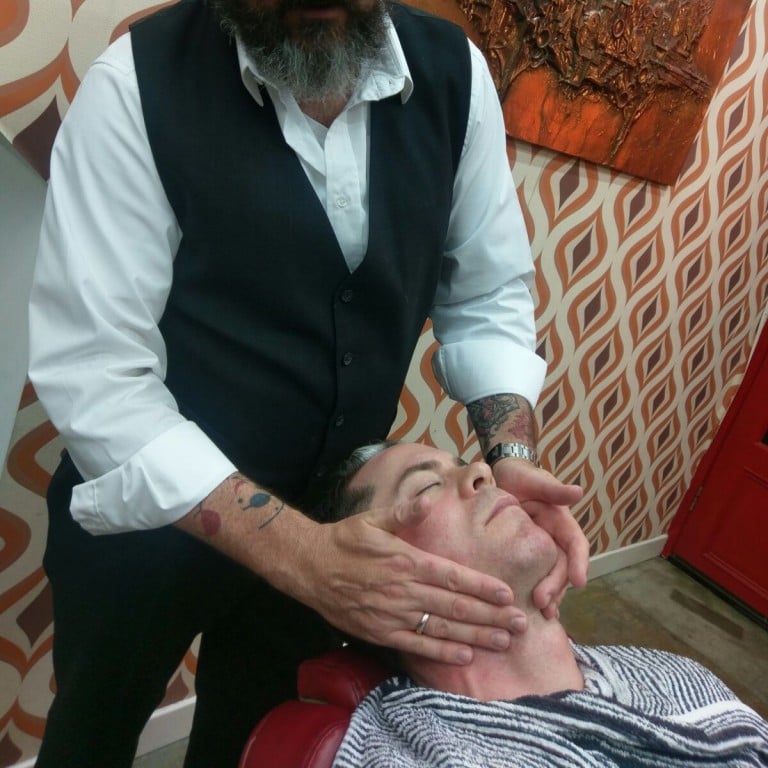Are old-fashioned shaves worth the time and money?

There is something languorously luxurious about taking the time to do a traditional wet shave. Just like getting a bespoke suit made rather than simply buying off the rack, there is a certain satisfaction that comes with spending the time (and the money, if you’re getting it done by a professional) on getting a proper, old-school shave.
Late last month, the skincare brand Selvedge Grooming launched in Hong Kong with a special pop-up event at Era Barbers, where master barber Lee David Stephens showed off his impressive shaving skills and shared his thoughts on why traditional wet shaves are increasing in popularity.
“Home shaving is something that’s relatively new, something that has happened in the last 60 years. Before that, the only people who could sharpen a blade enough were barbers, so men would go to barbershops to have a shave. It was only with the invention of the safety razor, which probably happened around the 1940s or 50s, that shaving at home became a real thing,” Stephens explains.
He points out that the most essential difference between an at-home shave and one at the barbershop is how barbers really take the time to prepare your skin.
“Men have different skin today [compared to 60 years ago]. We use moisturisers and stay inside in the air conditioning – our skin is more sensitive,” he explains. “A barber takes the time to prepare and massage your skin, get a good lather and use a hot towel. The application of the lather with the brush is the most important, as it really helps coat each hair and lift it away from the skin’s surface so it’s primed and ready for the sharp blade to pass over and remove it in one fell sweep.”
He says that when men shave at home, they often don’t prepare the skin enough, with the result that they often have to go over and over the same area to get a close shave, and when this is done with a disposable cartridge with three blades, it can cause a fair amount of skin irritation.
Professional shaves are certainly more expensive now – Stephens estimates the price 60 years ago to be mere pocket change, whereas it’s now in the hundreds – but it’s a luxury that’s worth every penny.
“This is for a man who likes to take care of himself, who has strong opinions about grooming,” he says. “When they want to treat themselves, when they want a little bit of relaxation, they opt for a traditional wet shave.”
Stephens says that while spas and salons have become increasingly unisex in their offerings over the years, the trend seems to be reversing.
“Now, many men are more interested in going to men-only barbershops to groom themselves and treat themselves to procedures that are inherently male,” he says. “Facials, waxes and massages are all unisex treatments that men and women can both enjoy, but a traditional wet shave? That’s a man’s thing.”
Keen to give it a go at home? Stephens walks us through the steps of a traditional wet shave:
Prepare the skin: choose a good cleanser and massage it into your face
Apply a hotel towel: this increases circulation, relaxes the skin and gets it warm and soft
Remove the cleanser
Get foamy: create a thick lather in a bowl with your brush and apply it over the skin, making sure every single hair is coated and is lifted off the skin as much as possible
First passing: using a straight-edged razor, get rid of the bulk of the hair
Repeat: reapply the shaving foam, using a wetter solution so it’s softer, then fine-tune the shaving job
Wipe off the foam
Get cool: apply a freezing cold towel to invigorate your skin; this contracts the capillaries and tightens the pores
Finish: soothe your skin with an after-shave balm and a protective moisturiser. Stephens recommends a light and mattifying moisturiser for men
Stephens uses Selvedge Grooming products, which are available at Era Barbers and Harvey Nichols
Additional reporting by Vivian Chen
Want more articles like this? Follow STYLE on Facebook

Traditional wet shaves are making a comeback. Here’s why